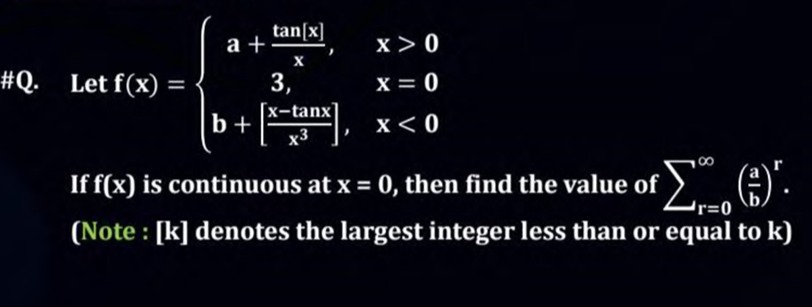Question
Question: Let $$ f(x) = \begin{cases} a + \frac{[tan(x)]}{x}, & x > 0 \\ 3, & x = 0 \\ b + [\frac{x-tanx}{x^3}...
Let
f(x)=⎩⎨⎧a+x[tan(x)],3,b+[x3x−tanx],x>0x=0x<0If f(x) is continuous at x = 0, then find the value of ∑r=0∞(ba)r.
(Note : [k] denotes the largest integer less than or equal to k)

4
3
1
2
4
Solution
For the function f(x) to be continuous at x=0, the following condition must be met: limx→0−f(x)=limx→0+f(x)=f(0) We are given f(0)=3.
1. Evaluate the limit from the right (x→0+): For x>0, f(x)=a+x[tan(x)]. As x→0+, x is a small positive number. For x∈(0,1), the greatest integer function [x]=0. Thus, tan[x]=tan(0)=0. limx→0+f(x)=limx→0+(a+x[tan(x)])=limx→0+(a+x0)=a For continuity, a=f(0)=3.
2. Evaluate the limit from the left (x→0−): For x<0, f(x)=b+[x3x−tanx]. We need to evaluate the limit of the argument of the greatest integer function: limx→0−x3x−tanx. Using the Taylor series expansion of tanx around x=0: tanx=x+3x3+152x5+O(x7) Substituting this into the expression: x−tanx=x−(x+3x3+152x5+O(x7))=−3x3−152x5+O(x7) Now, divide by x3: x3x−tanx=x3−3x3−152x5+O(x7)=−31−152x2+O(x4) As x→0−, x2 is a small positive quantity. Therefore, −152x2 is a small negative quantity. This implies that x3x−tanx approaches −31 from values slightly less than −31. Let y=x3x−tanx. As x→0−, y≈−31−(small positive number). For example, y could be approximately −0.33333−0.00001=−0.33334. The greatest integer of such a number is: [x3x−tanx]=[−31−152x2+O(x4)]=−1 So, the limit from the left is: limx→0−f(x)=limx→0−(b+[x3x−tanx])=b+(−1)=b−1 For continuity, b−1=f(0)=3. This gives b=4.
3. Calculate the sum of the geometric series: We have found a=3 and b=4. We need to find the value of ∑r=0∞(ba)r. Substituting the values of a and b: ∑r=0∞(43)r This is an infinite geometric series with the first term A=(43)0=1 and the common ratio R=43. Since ∣R∣=∣43∣<1, the series converges. The sum of an infinite geometric series is given by 1−RA. Sum=1−431=411=4
